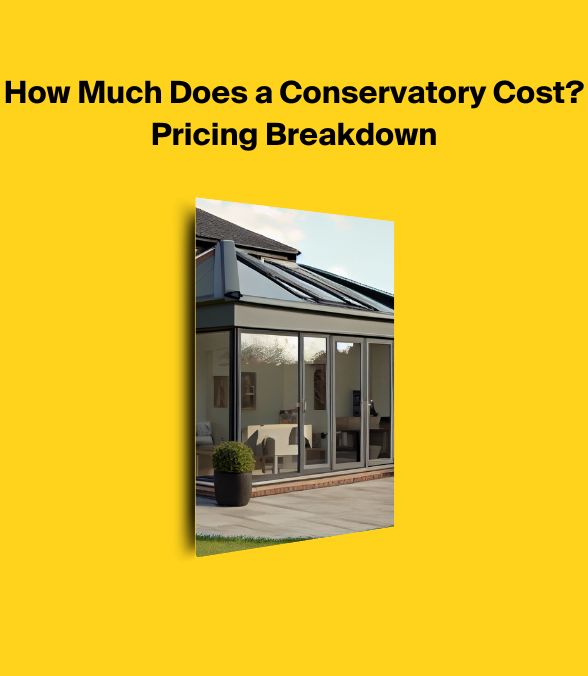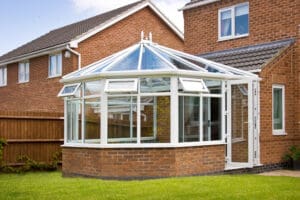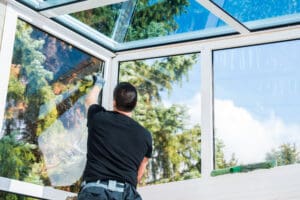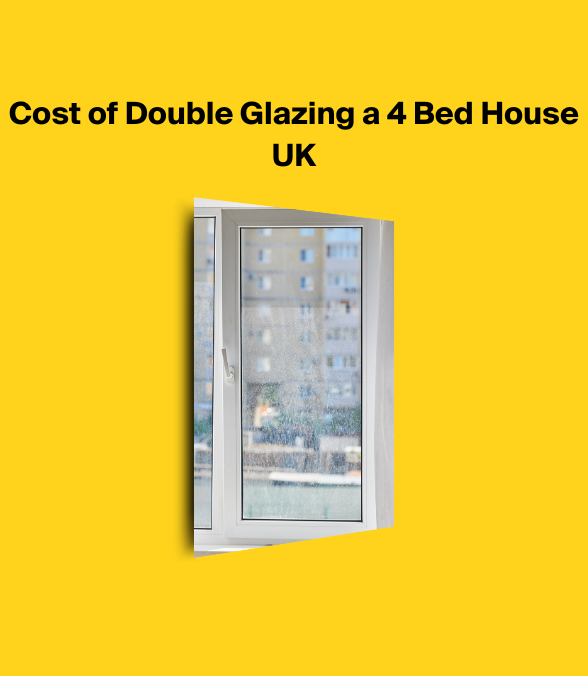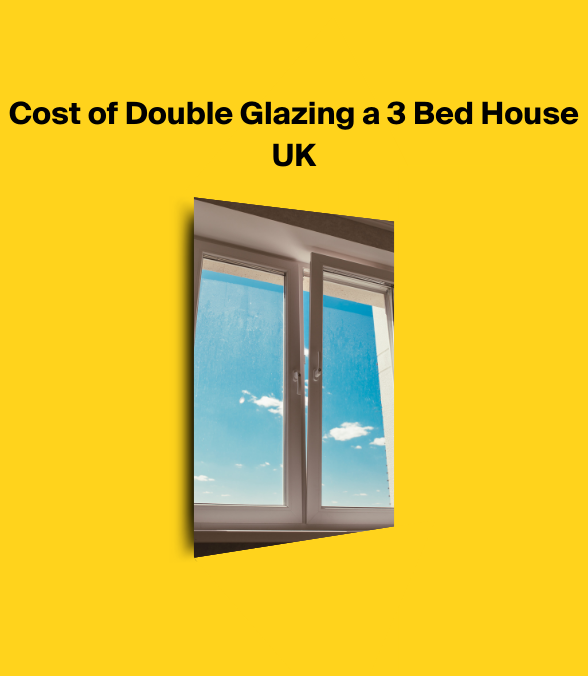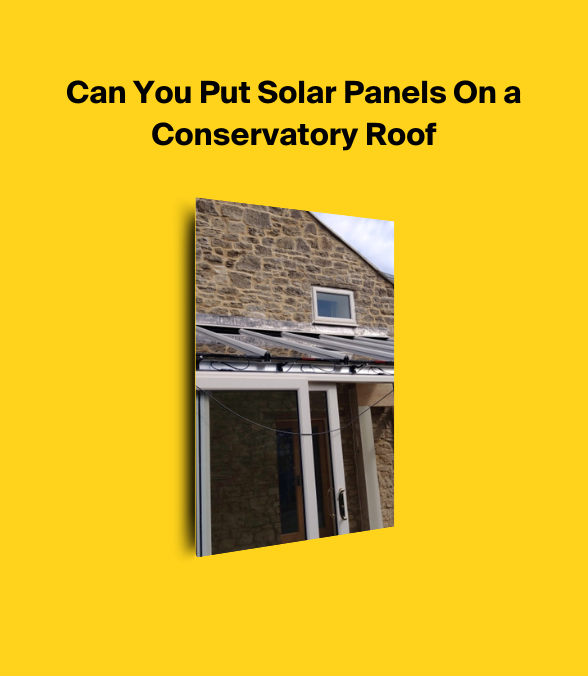Conservatory Prices - How Much is a Conservatory?
Considering adding a conservatory to your home and need to budget accordingly?
The cost of installing a conservatory varies widely based on factors such as size, style, materials, and location.
Whether you’re considering a lean-to for its simplicity and affordability or a Victorian style to add elegance to your property, understanding the cost implications is essential. In this guide, we’ll break down the conservatory cost in the UK to help you make an informed decision.
Get a quote for a new conservatory - click here
Conservatory Prices Overview
- Conservatory costs vary significantly based on factors such as size, style, materials, and location, with larger and more elaborate designs like Victorian or Edwardian styles generally costing more than simpler lean-to conservatories.
- The type of materials (uPVC, aluminium, timber), quality of glazing, and location of installation all considerably impact the pricing, with uPVC being the most cost-effective and environmentally friendly option.
- Additional features such as roofing materials, underfloor heating, and door and window designs, as well as regulatory aspects like planning permission and building regulations, can further influence the final cost of a conservatory.
Fully Fitted Conservatory Prices
Conservatory costs fully fitted can be influenced by a myriad of factors, including:
- Size
- Style
- Materials
- Location
For instance, larger conservatories generally require more labour and materials, thus increasing the cost. Similarly, the style of the conservatory can significantly impact the price, with elaborate designs like Edwardian and Victorian conservatories typically costing more than simpler ones like the lean-to style.
Equally important are the materials used and the location of the project, both of which can heavily influence the total cost.
Get a quote here for a new conservatory >
Size and Style
The overall dimensions and style of your conservatory play a crucial role in determining the final cost. Larger conservatories require more materials and labour, which naturally increases the price. For example, the 5m x 3m conservatory cost is going to be more than the 4m x 3m conservatory cost, as the structure is bigger.
The style can also impact the cost, with different designs producing different conservatory costs.
For instance, a lean-to-style conservatory with a sloping roof might be a more cost-effective solution for those on a tighter budget, as it requires less complex construction compared to more elaborate Victorian or Edwardian styles. So, if you’re looking to keep costs down but still want to add much-needed extra space to your home, a lean-to style might be the perfect choice for you.
Material Choices
The choice of materials for the construction of your uPVC conservatory is another significant determinant of the overall cost. The most cost-effective material is uPVC, while aluminium and timber can increase the cost by roughly 25% and 50% respectively due to their durability and aesthetic appeal.
However, choosing uPVC not only helps to minimise the cost but also supports environmental sustainability owing to its recyclable properties.
Location Factors
Location is another key factor that affects conservatory costs. Region-specific labour and material market conditions can significantly influence the final price.
For instance, in the UK, conservatory costs are generally higher in the south and in major cities like London, reflecting the regional discrepancies in labour costs and material prices. However, it’s worth noting that these prices can also vary considerably based on specific project requirements.
Get a quote here for a new conservatory >
Conservatory Types and Their Prices With Fitting
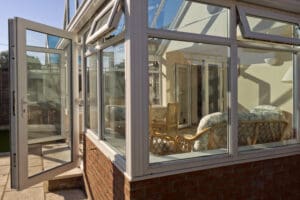
When it comes to different conservatory types, the most popular options in the UK are:
- Lean-to: This style has a simple and sleek design, and is often the most affordable option.
- Victorian: This style is known for its elegant and ornate features, and is a popular choice for traditional homes.
- Edwardian: This style offers a more spacious and open design, and is often chosen for its versatility.
Here is a quick guide so you know what to expect:
| Conservatory Types | Size | Price Range |
| Lean-to | 3x3 | £10,150 |
| Victorian | 3x3 | £16,500 ~ £34,500 |
| Edwardian | 3x3 | £11,000 ~ £13,500 |
Each of these styles has its unique charm and varying costs depending on size and materials. Meanwhile, the intricate designs of Victorian and Edwardian conservatories can add an element of grandeur to your home but come with a higher price tag.
Check out our in-depth breakdown of how fully fitted conservatory prices are effected below.
Lean-To Conservatory Costs
Lean-to conservatories are the most affordable option among the popular conservatory styles. Here are some costs to consider:
- Costs range from £8,000 to £15,250 depending on size and materials.
- The average cost for a uPVC lean-to conservatory is approximately £10,150.
- A 3m x 3m lean-to conservatory roof made of polycarbonate material could be re-roofed for between £1,900 and £2,900.
This type of timber conservatory offers a cost-effective way to expand living space and bring more natural light into a home, making it a popular choice among traditional conservatories.
Opting for a glass roof or roof lantern, which is favoured for its aesthetic appeal and insulation properties, would increase the cost to around £2,500 to £3,200 for the same size lean-to conservatory.
You can read our advice on new roof lantern costs here, giving you a better idea of what kind of total price you could be paying for a conservatory.
Edwardian Conservatory Costs
Edwardian conservatories are more expensive than lean-to styles, with conservatory prices starting from £16,500 and reaching up to £34,500 for larger or bespoke installations.
The elegant and timeless design of Edwardian conservatories adds a touch of sophistication to your home, but this comes at a premium. So, how much does a conservatory cost? As mentioned, prices can range from £16,500 to £34,500 depending on size and customisation.
For instance, a polycarbonate roof for an Edwardian-style conservatory measuring 3m x 3m can cost between £3,600 and £4,400, reflecting the added cost due to the stylistic design.
Victorian Conservatory Costs
The cost of Victorian conservatories typically falls between £10,000 and £15,000, with prices increasing for larger sizes and premium materials. Here are some examples of the cost breakdown:
- A small 3m x 3m Victorian conservatory with a polycarbonate roof can cost between £10,000 to £13,500.
- Opting for a glass roof would increase the price from £11,000 to £13,500.
- If you prefer a tiled roof, the price increases further to approximately £17,000 to £27,400.
For larger sizes, such as a 4m x 4m aluminium conservatory with a glass roof, the starting price for a Victorian conservatory is around £23,600.
Get a quote here for a new conservatory >
Additional Features and Their Impact on Cost
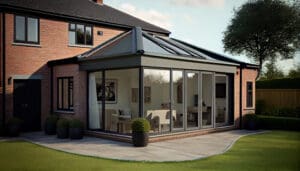
Additional features like roofing options, underfloor heating, and specific door and window designs can add to the overall cost of a conservatory.
While they may initially seem like luxuries, these enhancements can greatly improve the comfort and usability of your conservatory, making them well worth the investment.
From aesthetics to energy efficiency, these additional features can truly transform your conservatory into a year-round living space.
Roof Options
Your choice of roof material can significantly affect the overall cost of your conservatory. The most affordable option is a polycarbonate roof, while glass roofs typically cost more. However, a glass roof can offer superior insulation and aesthetic appeal.
Furthermore, advanced glass options, like self-cleaning or solar control glass, are available, which can add further to the cost but offer long-term benefits in terms of maintenance and energy efficiency.
You could also have solar panels on a conservatory roof if you wanted to go completely green, but expect to pay over £4000 more for this set up.
See our guide on different conservatory roof types to find out what kind of options you can choose from and to help you decide which type suits your home.
Underfloor Heating
Underfloor heating in a conservatory adds comfort and allows the space to be used all year round, potentially enhancing the value of your home. While underfloor heating adds to the comfort of a conservatory, it also results in increased initial costs.
However, it can prove to be a wise investment in the long run as it is more energy-efficient than traditional heating systems, leading to lower energy bills.
Doors and Windows
The choice of doors and windows in your conservatory can significantly influence the overall cost. From conventional French doors to modern bi-fold doors, each type offers a unique style and functional attributes that can affect the price. Similarly, the type of window glazing you choose can substantially impact the final cost. Some options include:
- Standard glass
- Self-cleaning glass
- Solar control glass
- Noise-reducing glass
Consider these factors when planning your conservatory to ensure it fits within your budget.
However, investing in energy-efficient doors and windows can lead to energy savings and reduced heating costs, despite the higher initial expenses.
Want another option? - read our guide all about orangeries.
Get a quote here for a new conservatory >
Planning Permission and Regulations
Obtaining planning permission can be necessary when planning a conservatory project and can significantly impact the overall cost.
Furthermore, building regulations approval may not be typically required for conservatories; however, when a conservatory is large, structurally independent, or features certain installations, regulations and associated costs become applicable.
When Do You Need Planning Permission?
In general, planning permission is required for conservatories that exceed certain size limits or cover more than 50% of the original house’s area.
Failure to adhere to these requirements, where necessary, could result in legal action and associated costs, including potential fines or the requirement to modify or remove the conservatory structure.
Building Regulations
While conservatories are often exempt from building regulations, certain circumstances require adherence. For instance, creating a new structural opening between the conservatory and the main house requires approval of building regulations, regardless of the conservatory’s exemption status.
Similarly, replacing a conservatory’s translucent roof with a solid one generally requires a building regulations application.
Non-compliance can lead to the necessity of retrospective planning permission, additional expenses, and potential legal complications.
DIY vs. Professional Installation
Whether you build a conservatory yourself or hire a professional for the installation depends largely on your budget, skill level, and the complexity of the project.
While DIY conservatory installations can offer cost savings primarily in labour expenses, they require a certain level of skill, understanding of construction, and potentially some specialised tools.
On the other hand, hiring a professional ensures that labour costs are included in their quoted price, which contributes to the overall higher cost compared to DIY.
DIY Conservatory Costs
A DIY conservatory installation can offer significant cost savings, but it also requires a considerable personal time and effort investment.
While you can save up to 50% compared to typical retail installed prices, this option may not include warranty options provided with some materials, such as those included in DIY conservatory kits. This may result in additional future costs due to the lack of protection against possible defects.
Professional Installation Costs
Hiring a professional for the conservatory installation not only ensures a safe and efficient construction process but also often includes a warranty for the work done, providing additional peace of mind and protection against future issues.
The average professional installation costs for conservatories vary by type. Still, they generally provide value for the money spent, especially for those who lack the necessary skills or time to undertake a DIY project.
Tips for Reducing Conservatory Costs
If you’re on a tight budget or simply looking to make your money go further, there are several strategies you can use to reduce conservatory costs. From effective budgeting and prioritising to smart material choices and thorough quote comparisons, saving on conservatory costs doesn’t have to mean compromising on quality or your dream conservatory vision.
Budgeting and Prioritising
Effective budgeting and prioritising are key to keeping your conservatory project within your financial reach. Consider the following factors that dictate the cost:
- Size
- Style
- Roof type
- Materials
- Groundwork
- Additional features
- Type of glazing
By prioritising these factors according to your needs and budget, you can control where your money goes and ensure that you’re investing in aspects that provide the most value to you.
Choosing the Right Materials
Choosing the right materials for your conservatory is a crucial step in ensuring long-term value and reducing maintenance costs. While high-quality materials may have a higher upfront cost, they can pay off in the long run by:
- reducing the need for frequent repairs or replacements
- saving you money
- ensuring that your conservatory maintains its aesthetic appeal and functionality over time.
Comparing Quotes
Finally, don’t forget to compare quotes from different installers before making your final decision. This can not only help you avoid overpaying but also give you a better understanding of what you’re getting for your money. Make sure each quote includes all necessary details to avoid any unexpected additional costs.
Remember, the cheapest quote isn’t always the best - it’s important to consider the quality of materials and workmanship as well.
Conservatory Cost UK - Final Thoughts
In conclusion, while investing in a conservatory can be a significant financial undertaking, understanding the various factors that influence the cost can help you make informed decisions and potentially save money.
From the size and style of the conservatory to the materials used and the location of the project, every aspect plays a part in determining the final cost.
Additionally, considering factors like the need for planning permission, whether to DIY or hire a professional and the impact of additional features can also greatly influence the price.
By effectively budgeting, prioritising, choosing the right materials, and comparing quotes, you can make your dream conservatory a reality without breaking the bank.
Get a quote here for a new conservatory >
Frequently Asked Questions
What is the average cost of a conservatory in the UK?
The average cost of a conservatory in the UK can range from £4,000 to £50,000 or more, depending on the size and type of the room.
Do you need foundations for a conservatory?
Yes, a conservatory needs foundations that are level, damp-proofed, and insulated in accordance with Building Regulations, just like any other building extension. It is essential for the stability and longevity of the structure.
Does a conservatory add value to a house?
Yes, a conservatory can increase the value of your home by up to 7%, depending on its quality, structure, and how well it matches the rest of the house. Careful planning and design are crucial for maintaining a consistent interior style with the rest of the home.
How much a conservatory is could have a big effect on how much value is added, with more expensive ones potentially adding more value.
Is a conservatory cheaper than an extension?
Yes, a conservatory is usually cheaper than an extension due to lower associated costs, such as architect fees and skip hire.
Whichever you get, you will likely a door in the structure so that you are able to get out. More often than not, they tend to be French doors or patio doors.
What factors influence the cost of a conservatory?
The cost of a conservatory is influenced by factors such as its size, style, materials used, location, and additional features like heating or specific door and window designs. Consider these aspects when planning for your conservatory project.

